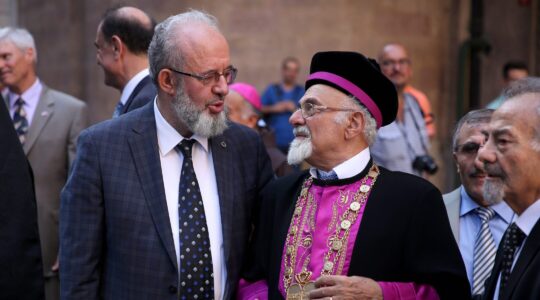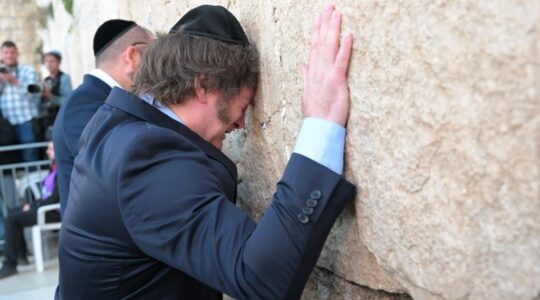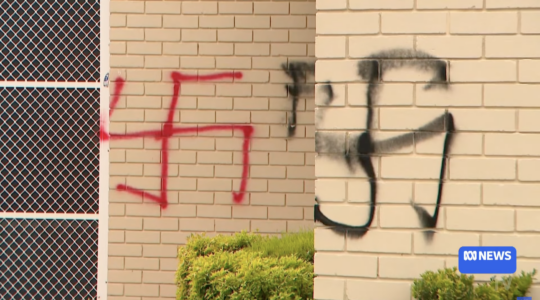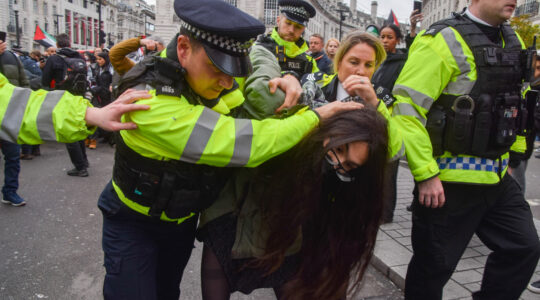
Dr. Alicia Gojman with a book of Yiddish poetry illustrated by Diego Rivera. (Ben Harris)
MEXICO CITY (JTA) — To most of the world, Diego Rivera is seen as one of the greats of Mexican art, the creator of legendary murals that adorn the walls of national monuments in Mexico City and elsewhere.
But for a small cadre of Mexican Jewish writers and intellectuals, Rivera was something of a landsman, a descendant of Spanish conversos who shared their left-wing politics.
Though Rivera never practiced Judaism or affiliated with Mexico’s tiny Jewish community, he nonetheless developed close friendships with a number of prominent Jews and even illustrated a book of Yiddish poetry, “City of Palaces,” by Isaac Berliner.
A first-edition copy of the book, along with articles from the Yiddish press describing Rivera’s exchanges with Jewish intellectuals, is held in Centro de Documentación e Investigación de la Comunidad Ashkenazí de México, an archive of historical documents of the city’s Ashkenazi community.
The United Nations Educational, Scientific and Cultural Organization recognized the archive last month as part of its Memory of the World program, which aims to preserve valuable archival collections.
“Diego always said that he felt close to the Jews because he had Jewish blood,” said Alicia Gojman, the archive’s director.
The archive was started 20 years ago and is now housed in a multi-story building in Mexico City’s Condesa neighborhood, a major locus of Jewish life in the middle decades of the 20th century and where a handful of Jewish institutions still reside. Its roots, however, go back to World War II, when the Allies were searching for places to send the cultural legacy of European Jewry that had been confiscated by the Nazis.
Among the archive’s materials, some of which are more than 400 years old, are Jewish books stamped with the Nazi emblem — volumes that were intended for a museum the Nazis were planning to show the history of an eradicated race.
Mexico’s Jewish community, which was made up of many refugees from Nazi Germany, agreed to take 1,000 volumes. Over the years the archive expanded, as Jewish Mexicans began contributing volumes from their private collections.
But the Rivera material is arguably among the most unique parts of the collection, helping to fill in aspects of Mexico’s Jewish history that aren’t widely known.
Rivera used his influence with Mexican authorities to help another Jew fleeing persecution abroad, according to Gojman. When Leon Trotsky arrived in Mexico, he lived in Rivera’s home for a time, and his secretary was a Mexican Jewish woman who spoke fluent Russian.
Among Rivera’s famous murals is one from 1947 that begins with an image of a young girl from the Carvajal family, a group of Spanish conversos accused of heresy by the Inquisition and burned at the stake in the last years of the 16th century.
To Gojman, it is telling that Rivera began his pictorial history of Mexico with an image evoking the plight of Jews under the Inquisition.
“I think, when I read his sayings and his works, that he was acquatinted with the story of the Carvajal,” Gojman said. “He was touched about what the Inquisition did to the Jews of Spain.”
JTA has documented Jewish history in real-time for over a century. Keep our journalism strong by joining us in supporting independent, award-winning reporting.





